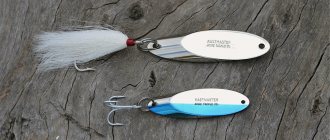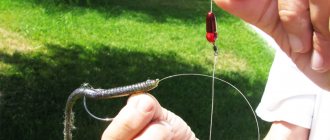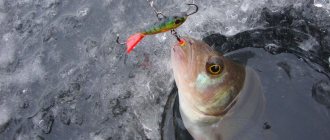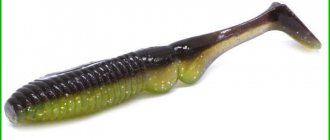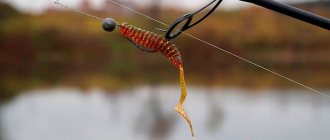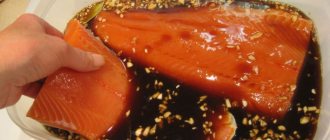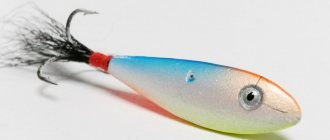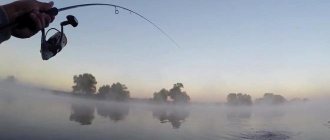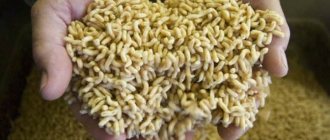Open and plant-free reservoirs are not always suitable for pike fishing. In an overgrown pond or reservoir sump you can achieve much more excellent results. But the spinners and classic wobblers with tees will not swim far here - they will immediately get tangled in the grass or stick into snags. However, there is one option suitable for such conditions - Croatian egg fishing. About the features of this bait, its pros and cons, and its wiring options in this article.
What is a Croatian egg
Croatian egg is a spinning surface bait made of lightweight material: balsa, plastic, cork or foam, and designed for catching pike.
Its rounded part is equipped with a ring for mounting a fishing line, and on the other side there is a hook (single or double). Inside the bait, in the belly, there is a weight. Thanks to this, when wiring, it is always in the hook-up position.
The product is shaped like an egg – hence the unusual name. When making it with their own hands, many fishermen use various available materials, but the classic model is made exclusively from balsa. Its average weight is from 5 to 15 grams.
The official name of this lure is Bumble Lure. It was invented by Branimir Kalinic (pictured below) from Croatia. Russian spinners brought it to their homeland after a bass tournament held in this country in 2006.
How to make a Croatian egg with your own hands
The original Bumble Lure lures are made by hand, which makes them very expensive. Therefore, spinning anglers often purchase cheaper analogues. For example, a Croatian egg from the German manufacturer is not inferior in performance characteristics and has different colors, sizes and shapes.
If you couldn’t find an option from those presented in the store, then you can make a Croatian egg with your own hands. Following the instructions guarantees a good result.
Manufacturing
To make a Croatian egg with your own hands, you can use blanks from linden, pine, birch, alder, or even a wine cork. You also need to prepare a hacksaw, a grinder, a vice and a screwdriver.
Work begins with processing a wooden blank, which should ultimately take the shape of an egg. The main mass is cut off and adjusted to an approximate shape.
Next, the workpiece is sanded: first, use coarse-grained sandpaper, gradually replacing it with fine-grained sandpaper. The final stage is zero grinding. Using a lathe will make the task easier, but not everyone has one.
Loading
Accuracy and casting range, performance characteristics depend on the load of the bait. The location of the center of gravity determines functionality and balance.
To do this, lead weights are used, which are inserted inside a wooden blank. To insert them, a slot is made in the widest place in the direction from one vertex to the other, while it goes deep only to the central axis.
First, a hook with a long shank is inserted, and its fastening eye is connected to the fastening ring of the Croatian hook using twisted wire. The hook tip is at least 30 mm long and is directed upward towards the back. For clear fixation, epoxy resin is used.
Lead weights are inserted into the slot along the cutting arc. The heaviest ones are used for the central part, and the lightest ones for the tops. Filling voids and fixing pellets is also done with epoxy resin. After complete drying, the excess is cleaned off and sanded flush with the previously prepared surface.
Load test
The bait, which the fisherman makes himself, is checked after a test load. The test is quite simple: the workpiece is placed on a flat surface and, due to the weight of the load, it is always held correctly, that is, with the tip up. When rocked, it returns to its original position. Next, a test is carried out in water to determine sediment.
Note! Ideally, the bait is only half of its body immersed in water or slightly below the central axis, while the sting does not sink and is directed straight up.
If during any of the tests the workpiece behaves “wrongly,” then it should be corrected. Check the correct position of the hook and fastening with the ring inside, or change the location of the load. There is no point in releasing non-working bait into the lake: it will not attract fish.
Finishing
When the test tests are successfully completed and the required characteristics are achieved, the workpiece is subjected to rough finishing. During this procedure, such material shortcomings as:
- moisture absorption of the material;
- increase in density;
- preparation for final painting.
The egg is completely treated with epoxy resin, and after complete drying, the surface is sanded to a matte state.
Before the next step, you need to make sure there are no pores.
Coloring
The workpiece is painted in 2 steps. First, it is coated with white paint and, after complete drying, painted in the chosen color. It is preferable to use fluorescent aerosol paints. To imitate scales, use a nylon mesh, and when using 2 different paints, you will need stencils.
Holographic stickers are placed in place of the eyes and secured with quick-drying glue.
After complete drying, the Croatian egg tackle is tested in real conditions, and wiring is practiced on a pond.
Where and when to apply
Thanks to its design, the Croatian egg allows you to fish in areas of reservoirs covered with dense aquatic vegetation, including a continuous carpet of algae.
Some models are equipped with additional “antennae” or silicone feathers, which allows them to be used as non-snags in the most difficult places.
Fishing with such baits is very exciting and dynamic. You literally watch the pike come out of ambush, chase the bait and attack vigorously.
Review #2
Greetings colleagues.
I'll add my experience. The Croatian egg bait is very interesting; I purchased it several years ago, but I only managed to catch it well last season.
The sea brings emotions, for me it is the most spectacular bait for pike fishing. Several times it helped me out in moments of no bite in the heat, when the pike practically did not react to anything else; guiding the Croatian through the carpet of algae simply worked wonders. A seemingly lifeless overgrown backwater, the July heat, throwing an egg into a carpet of water lilies, a couple of meters of wiring and a 1.5-2 kilogram pike torpedo flying out of the water with a splash.
A very interesting fact is the implementation of bites for the Croatian egg. There were up to 20 exits with blows, bites, candles and other things for one caught tail. It happened that every 3-5th exit of pike could be realized. Here it seems to me that everything depends on the toothy’s mood and activity.
Wiring - from small continuous twitches with constant reeling, somewhat similar to a walker's wire, to rather sharp pulls of 40-60 cm with short pauses between them.
All of the above applies specifically to the Croatian balsa egg (original), I have not tried analogues yet, I have not hooked rubber on the hook. I would also like to note the VERY WEAK paint and varnish coating of the Croatian egg. In some cases, after only 3 bites, the Croatian began to “drink water”; it needs to be additionally treated with varnish.
Kinds
The Croatian spinning egg comes in 2 shapes:
- Popper - there is a recess on the front round part that creates a gurgling sound and splashes when wiring. It has a long hook. Popper works better in more open areas, in windows of vegetation.
- Walker - its ovoid shape without cuts or irregularities gives sliding properties, and the bait does not catch on the grass, because the shank of the hook is directed upward. Suitable for catching predators where there is a lot of vegetation.
Photo: Croatian egg bait and its varieties - popper (left) and wolfer (right)
What does a Croatian egg look like and what kind of fish are caught with it?
The Croatian egg is part of the standard equipment of almost every fisherman. The main purpose is to catch predators in dense thickets. By the way, he copes with the task perfectly.
What it is
The Croatian egg is a wobbler favorite among spinning fishermen. The bait is made in the shape of an egg, and the first inventors were the Croats, which is how it got its slang nickname.
What does it consist of?
Light buoyant materials are used as material for making the body. Most often it is plastic or dense wood.
From the narrower pointed edge comes a hook equipped with a long shank, and a fastening ring is built into the blunt part.
To make a Croatian woman more attractive, her body is painted in bright colors, and holographic stickers are added to the front, where the eyes should be.
Where is it used?
The Croatian egg bait performs well in well-warmed water, that is, in summer. Autumn fishing with eggs is less effective, and for winter fishing it is completely unsuccessful.
Note ! The Croatian fish is good for perch and pike, and thanks to its shape it can be used even in ponds overgrown with snags and algae.
Advantages and disadvantages
The body of the bait is half immersed in the water, and the hook with the point always remains at the top. This feature allows the simulator to pass through areas with dense algae without getting caught.
However, it is necessary to take into account seasonality: the tackle is used in the summer, and in the winter a spinner will be an effective replacement.
Advantages and disadvantages
First, let's look at the strengths of the bait:
- Long casting – thanks to the rounded shape and position of the weight, the Croatian egg has good aerodynamics.
- When reeling, the bait creates a strong vibration in the water, which looks impressive and even attracts fish from afar, provoking it to bite.
- The Croatian egg does not catch on grass and snags, like spinners, wobblers-poppers, etc. The ovality and well-thought-out weight make it a “tumbler”, and it always remains with the hook up. Sometimes this is the only spinning bait that can be used in densely overgrown ponds or peat bogs.
Photo: Croatian egg Akara Crazy Egg 55F, color options
Despite the advantages, the bait also has its disadvantages:
- used for fishing in warm water when fish hunt closer to its surface;
- The bait is made of fragile material, and pike bites through it easily. The Croatian egg can then absorb water in places of damage and lose its shape, becoming unusable faster than other types of bait. Therefore, fishermen try to use such equipment in heavily overgrown reservoirs, where other options will not work or to attract sluggish fish;
- For 10 bites, there may be only 2-3 fish caught, because it can grab a round bait from the side or break off a single hook.
Tip: you can increase the effectiveness of bites by hanging a twister on the hook that imitates a worm - its game will make the “Croatian” even more attractive to predators.
Place and time of application
Croatian eggs are popular with fishermen all over the world; in Russia they help to successfully catch pike. As you know, pike fishing often takes place in overgrown reservoirs, where this wobbler has proven itself well. People call this bait “Croatian”; it is effective in small, completely overgrown reservoirs.
It is the non-catching nature that makes it possible to move the Croatian bait in those places where another bait will catch.
The Croatian egg is used under any conditions, even in thickets of water lilies and in the presence of snags, fishing will bring unexpected success. You can fish with it even at a time when the mirror of the pond is covered with grass raised from the bottom. This wobbler belongs to baits that work on the surface of a reservoir, therefore, fishing should take place in warm water. It is very convenient to catch Croatian in late July - early August. It is at this time that the pike goes hunting in the most grassy places.
Catching pike with a Croatian egg
To attract pike, the following types of wiring are used:
- Light jerks - the bait moves in a straight line with a small amplitude.
- Uniform with speed adjustment - the thicker the thicket, the slower the scrolling so that the fish has time to follow the bait and take aim.
- Stop and go – alternating periods of movement and stops. This method is suitable for stimulating a passive pike.
- Maneuvering – used when the appearance of a keel wave shows that the pike is approaching from afar. If you slow down, the predator may lose interest, and if there is nowhere to lead, the “Croatian” is twitched in place.
- “Glider” - after casting, the bait is led slowly and swayed, then the retrieve is accelerated, maintaining the sway, then the fish mistakes it for a frog.
In the video below you can see the process of fishing with a Croatian egg. It is quite interesting and spectacular, and the fisherman’s vivid emotions are proof of this:
Catching pike with a Croatian egg in an overgrown pond is not just fishing, but a spectacular game of bait, an opportunity to show dexterity in maneuvering and resourcefulness in choosing the fishing method.
What types of Croatian egg bait are there?
The Croatian egg consists of a main element that is located on the surface, a large hook, usually single, although there are specimens with doubles. And a sinker, which is needed to give the nozzle the required position. The hook is always directed upward, so snags on algae are completely eliminated.
The Croatian egg comes in two types: round (glider) and popper, it has a small cut in front. This must be taken into account when choosing a reservoir. If the surface is completely clean or with a small amount of vegetation, then a bait with a cut will work well. If there is a lot of grass, of course you need to use a round wobbler.
Also, when choosing a pond, you should take into account the size of the hook. A long hook is suitable for fishing on a flat surface. Fishing on the “grass carpet” should be equipped with a short hook. The shape of the egg prevents the bait from turning over, thereby forcing the hook to be in a vertical position.
